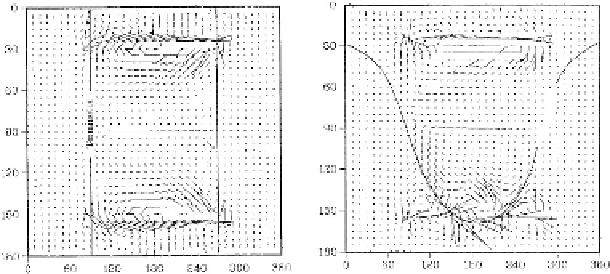Geoscience Reference
In-Depth Information
localtime
localtime
Fig. 9.4.
(a) The same as in Fig. 9.3, but for source of 180
◦
azimuthal width.
Equinox. (b) The same as on left frame, but for the summer in the Northern Hemi-
sphere
The spreading pattern changes abruptly, going from the equinox to sum-
mer or winter. Figure 9.3 (right frame) shows the current distribution for the
'bell'-like magnetic component of the magnetospheric source of the Alfven
wave for summer in the Northern Hemisphere. The bold solid line approx-
imately represents the terminator position. One can see a strong transfor-
mation of the current in the Southern Hemisphere due to the vicinity of the
terminator to the equivalent current source. Due to the dipole character of the
source, and as its sequence due to the fast decreasing of current when mov-
ing away from the source, the terminator does not influence the ionosphere
current distribution or the magnetic field under the ionosphere. In the North-
ern Hemisphere, winter conditions with the same source, symmetrical with
respect to the equator, we obtain the same equivalent currents distribution
Ψ
sol
as in the Southern Hemisphere (Fig. 9.3).
When the pulsation source is large-scale along a parallel (this is valid for
Alfven waves with small azimuthal wavenumbers) and its length is compara-
ble with the distance to the equator, the spatial spreading of such field-aligned
currents changes abruptly. The intensity of the spreading currents and their
magnetic field on the ground grow in the equatorial region (see Figure 9.4a
for the equinox, and Fig. 9.4b for the summer in the Northern Hemisphere).
An additional maximum in the latitudinal pulsations intensity distribution
appears in the equatorial region. A strong current flows along the terminator
and closes upon the source through the equator due to the weak space decre-
ments, contrary to the case of high wavenumbers in which there is a strong
interference at adjacent source edges. In Fig. 9.4b the source is in the Southern
Hemisphere. An anomaly in the magnetic vector rotation is clearly seen at the
equator. A maximum deviation of about 1 hour takes place before the arrival
of the terminator. It is clear that for other seasons (summer in the Southern
Hemisphere), the magnetic vector will turn symmetrically about the equator.

Search WWH ::

Custom Search